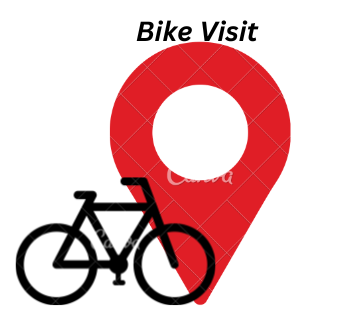
A slow-moving bike can be a frustrating experience. Especially when your bicycle doesn’t seem to keep up the pace and you don’t seem to know the problem. You may ask, “Why does my bike feel like it’s dragging?
In most cases, fixing the issue can be simple… only if you know where to look.
Reason Why My Bike Feels So Slow?
Brake Rubbing
When the bicycle brakes are properly adjusted or the wheels are not correctly aligned, this may cause the brakes to clash with the rim or motor.
This occurs when your brake pads are touching the wheel, creating friction even when you’re not applying the brakes, But it feels like you’re slightly braking
The first thing to check is brake adjustment, which depends on the type of brake you have. Rim brakes are easiest to detect because you can usually see the pad touching the rim. If it’s always touching without you pulling the brake level, then it’s probably brake adjustment.
The solution is relatively simple. Use an Allen wrench to loosen the bolt holding the brake pads in place, adjust the pads, and then tighten the bolt again. Be careful not to loosen them too much, or your brakes might not function effectively – test your brakes throughout the process.
Low Tire Pressure
A flat tire is the most common reason why your bike feels low. When your tires are under-inflated, resistance increases, making it harder to gain speed. Even if your bike tires don’t look, it’s more than likely softer than its convenient tire pressure.
Bike tires can lose air even when not in use which contributes to under-inflated tires, so it’s best to double-check the condition of your tires before cycling and assess whether it needs more psi.
Chain Needs Lube
Over time, your bike drivetrain – its chain, gears and derailleurs will gather a lot of excessive dirt buildup affecting the bike’s speed. Over time, your bike might feel slow due to increased pedalling resistance – you might feel as if you’re pedalling harder than usual to keep moving.
You can minimise this with regular lubrication and deep cleaning of the bike drivechain. Lubricating your chain, should be done twice a week however, it depends on the weather conditions you’re cycling in. If left neglected, it is only a matter of time before your drivechain will stop running smoothly.
It is also great practice to clean the drivetrain thoroughly. This is increase it’s life and minimizes wear and tear.
Riding Against Headwinds (Weather)
Let’s face it, we as cyclists don’t have much control over the weather. Therefore in a scenario like this, you’ve to accept that the wind will make you slower than usual
Riding against a headwind can make your bicycle feel like it’s dragging or leaving feeling stagnant.
Headwinds are noticeable when you feel the wind blowing directly in your face, causing your eyes to sting and the wind to howl in your ears. This makes it challenging to pedal, you’re likely facing a headwind.
While you can’t change nor escape the wind direction, you can find a different route that is less exposed to the wind. Alternatively, you might have to come to terms and adjust your cycling efforts accordingly.
Fitness level
Your fitness level can significantly affect your bike’s performance which determines how fast or how slow you can cycle. Simply put, the fitter you are the faster you can cycle. This is regarded as the most important, yet hard to identify, because it is something we won’t notice right away unless we conduct a fitness examination.
If you sense a difference in physical fitness whether you find yourself out of breath after a short ride or your legs ache even after a cycling session, you probably experiencing signs of undertraining or overtraining
Chances are, you more than likely cycle less frequently or with the same amount of intensity resulting in a decline in performance – which explains why you’re feeling slower on the bike.
Noticing a loss of physical fitness can be an unpleasant situation and can be a catastrophe for psychological well-being, leaving you feeling unmotivated. But, neglecting your fitness is just as bad.
To combat this, adjust your training regimen. If you’re undertraining, gradually increase the intensity and frequency of your workouts.
Riding on Different Gradients and Terrains
From smooth roads to bumpy trails, When cycling we come across different terrains – rocks, roads, and forests. Different surfaces come with their own set of challenges, more specifically riding on uneven surfaces can be tricky. As things go, some terrains can make it harder to maintain traction, which could explain why your bike is slow.
In most cases, your bike might not be designed for certain surfaces. For example, a mountain bike might feel slower on the road compared to a road bike, as mountain bikes are not well-equipped for road use.
If you’re feeling slower on your bike than usual, it could be because you’re riding a slight gradient. It’s easy to miss an incline because it’s usually subtle, but if you notice your pace is slowing down even though you’re still pedalling, it could be a sign that you’re on an uphill.
If you want to figure out what’s causing your bike to slow down, try tracking the elevation using Google Maps, which displays the terrains in %.
Selecting the wrong gears depending on the terrain, leads to inefficient pedalling – which evidently makes you slower on the bike.
Carrying Excessive Weight
Although it might not seem significant, carrying too much weight can slow down your bike. This may include – a backpack, pannier, and saddlebag. The extra weight increases the effort needed to pedal.
If you’re a commuter and you carry a backpack or a pannier, check if you’re carrying unnecessary items that add extra weight to your load.
To solve this, regularly check and empty your bag. Discard any unnecessary items like spare accessories or extra clothing that you don’t need for your rides.
Change of Clothing
Yes, I know it sounds unusual, but believe it or not, wearing inappropriate clothing can also slow down your bike. Wearing tight-fitted jeans or pants can restrict your full range of motion – as they’re inadequate to produce maximum force throughout the movement. Not to mention, how uncomfortable it could be when cycling over long distances.
I personally opted for a looser fit- somewhere in between tight-fitted clothing, but not too baggy. If you’re wearing loose or baggy clothes during your rides, they might be slowing you down. Since baggy clothes increase drag, making you pedal harder to maintain your speed.
I tend to prefer clothing specific to cycling, as they are designed to be more comfortable and efficient on the bike by increasing the speed
